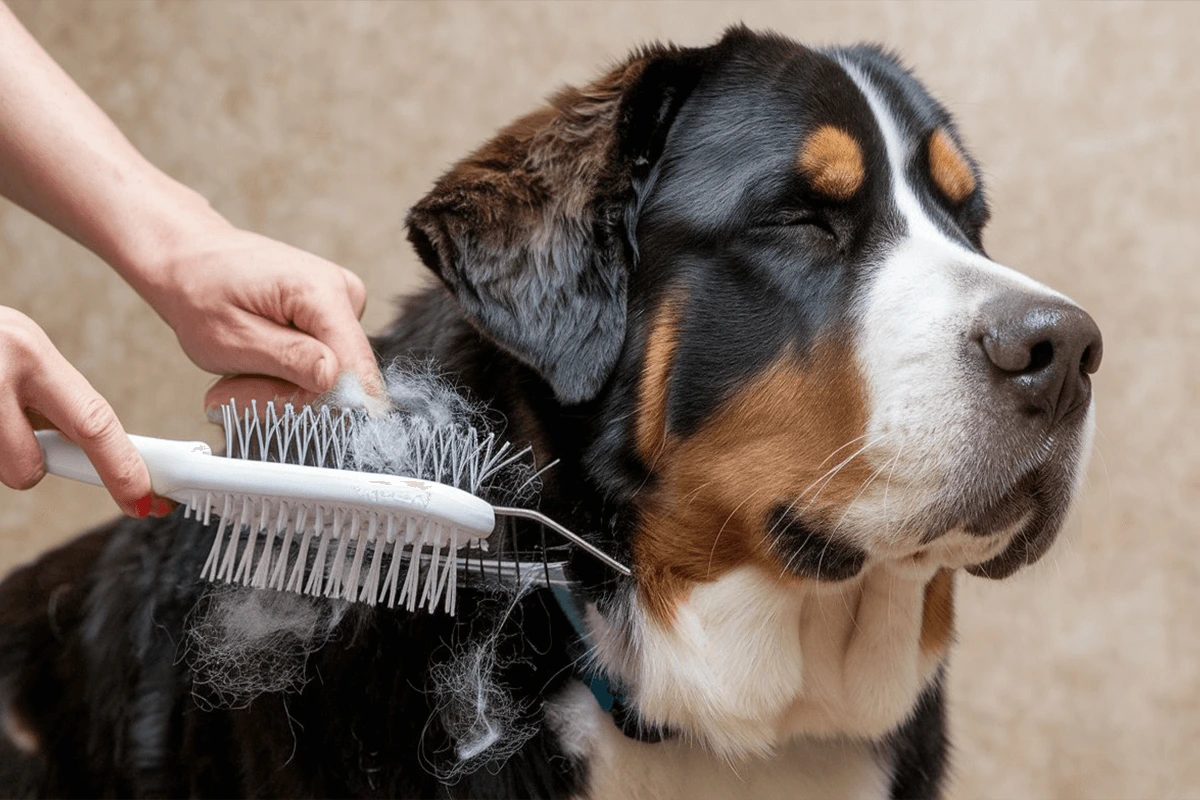Owning a Greater Swiss Mountain Dog comes with many rewards, but dealing with its shedding can be a challenge. This large, powerful breed has a thick double coat that sheds consistently throughout the year, with even heavier shedding during spring and fall. Without proper management, loose fur can quickly take over your home, sticking to furniture, clothes, and floors.
Understanding why and when your Greater Swiss Mountain Dog sheds will help you take control of the situation. With the right grooming tools, a consistent brushing routine, and a few strategic adjustments to your home and pet care habits, you can minimize excess fur and keep your dog’s coat healthy. This guide will walk you through everything you need to know, from choosing the best deshedding brush to using Omega-3 supplements for coat health.
By the end of this article, you’ll have a clear plan to manage Greater Swiss Mountain Dog shedding easily, ensuring a cleaner home and a happier, healthier pet.
Understanding Greater Swiss Mountain Dog Shedding
The Fur Shedding Cycle
A Greater Swiss Mountain Dog’s shedding follows a natural cycle that helps maintain a healthy, functional coat. This breed has a double coat, consisting of a dense undercoat and a coarser outer coat. The undercoat is responsible for most of the shedding, as it constantly renews itself. Loose fur falls out naturally, making room for new growth. Without regular brushing, this dead hair can accumulate, leading to tangles and mats that make grooming more difficult.
Unlike some breeds that shed minimally, Greater Swiss Mountain Dog shedding occurs consistently throughout the year. However, the amount of fur they shed varies depending on the season, their diet, and overall health. If a dog isn’t receiving proper nutrition, its coat may become dry and brittle, leading to excessive shedding. Stress can also impact the shedding cycle, causing temporary hair loss. Understanding how their coat functions and knowing what to expect allows you to stay ahead of shedding with a proper brushing routine, high-quality grooming tools, and a balanced diet that supports coat health.
By taking the time to groom your Greater Swiss Mountain Dog consistently, you can prevent excess hair from accumulating in your home and ensure that your pet’s coat remains soft, shiny, and healthy. Regular brushing not only reduces loose fur but also distributes natural oils throughout the coat, keeping the skin moisturized and preventing irritation.
Shedding Seasons
Although Greater Swiss Mountain Dog shedding happens year-round, it intensifies during two major shedding seasons—spring and fall. In spring, they shed their thick winter undercoat to prepare for warmer weather, leading to a heavy fur loss period. As temperatures rise, their body naturally adjusts by getting rid of excess insulation. This is when you may notice large clumps of fur coming out during brushing sessions or even gathering around your home.
In fall, the process reverses. As the days become colder, they shed their lighter summer coat to make way for a thicker, insulating winter coat. This transition is just as intense as spring shedding, making it essential to increase brushing frequency to keep the loose hair under control.
If you don’t keep up with regular grooming during these shedding seasons, fur can easily pile up on furniture, floors, and clothing. To stay ahead of the excess hair, brushing should be done at least three to four times a week, if not daily. De-shedding tools like undercoat rakes and slicker brushes can effectively remove loose undercoat fur before it spreads around the house. Keeping a pet-friendly vacuum on hand and using lint rollers on clothing can also make managing the fur much easier.
In addition to grooming, bathing during shedding seasons can help loosen dead hair and speed up the shedding process. Using a mild, moisturizing dog shampoo will prevent skin dryness and keep the coat in optimal condition. A proper grooming routine tailored to the shedding cycle will significantly reduce the amount of loose fur in your home and keep your dog looking and feeling their best.
Is the Greater Swiss Mountain Dog Hypoallergenic?
If you’re looking for a hypoallergenic dog breed, the Greater Swiss Mountain Dog is not the best choice. Greater Swiss Mountain Dog shedding releases fur and dander into the environment, which can trigger allergies in sensitive individuals. Dander, which consists of tiny flakes of skin, is a common allergen for people with pet-related allergies. When combined with the constant shedding of fur, it can quickly accumulate in the home, causing allergy symptoms like sneezing, itchy eyes, and congestion.
While no dog is truly 100% hypoallergenic, some breeds produce significantly less dander and shed very little, making them a better option for allergy sufferers. Breeds like Poodles, Portuguese Water Dogs, and Basenjis are often recommended for those with allergies since they have minimal shedding and produce less dander.
However, if you’re set on owning a Greater Swiss Mountain Dog despite allergies, there are ways to manage allergens effectively. Frequent brushing and bathing help reduce the amount of loose fur and dander in the home. Using a high-quality HEPA filter vacuum designed for pet hair can trap airborne allergens before they settle on furniture and floors. Regularly washing your dog’s bedding and keeping an air purifier in common areas can also improve air quality and reduce allergen levels.
Although Greater Swiss Mountain Dog shedding requires extra effort to manage, proper grooming, home cleaning, and air filtration can make living with one much more comfortable for allergy-prone individuals. If you’re willing to put in the work, this affectionate and loyal breed can still be a great companion.
Essential Grooming Tools for Shedding Control
Best Brushes for Shedding Dogs
Managing Greater Swiss Mountain Dog shedding starts with using the right grooming tools. Since this breed has a double coat, you need brushes that effectively remove loose undercoat fur without damaging the topcoat. Not all brushes work the same way, so choosing the right one can make a significant difference in controlling shedding and keeping your dog’s coat healthy.
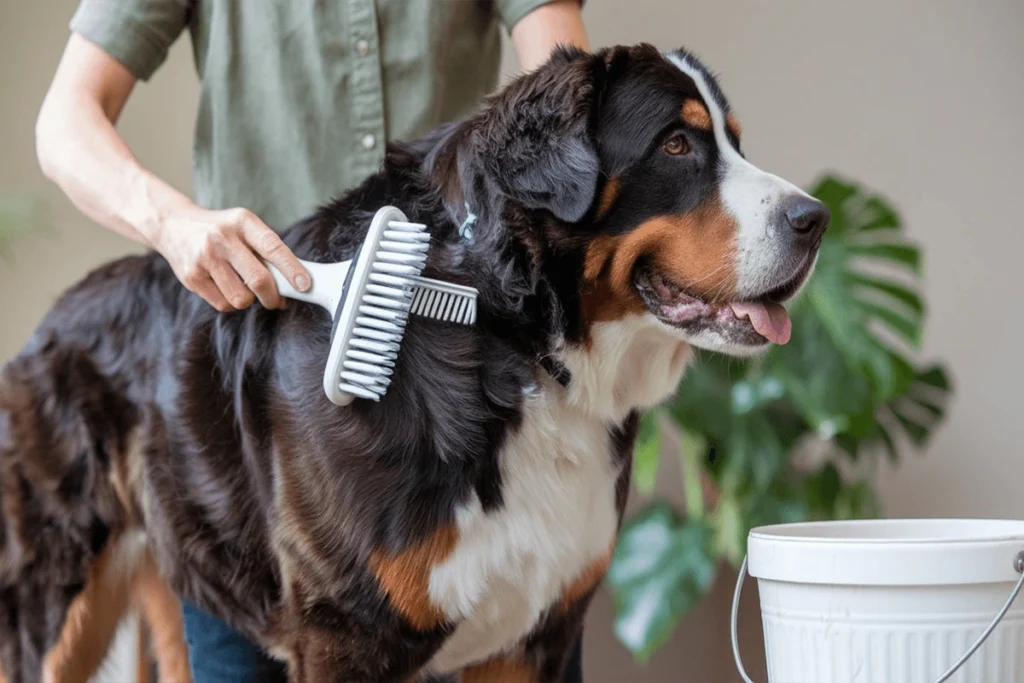
One of the best tools for a Greater Swiss Mountain Dog is a de-shedding brush, designed specifically for removing loose hair from the undercoat. These brushes reach deep into the coat, grabbing and removing fur before it falls onto your floors and furniture. Another essential tool is the undercoat rake, which works well during heavy shedding seasons in spring and fall, as it helps remove dead fur while preventing mats and tangles. A slicker brush is also useful for general maintenance, as it smooths the topcoat and helps distribute natural oils that keep the fur healthy.
For best results, use a combination of these brushes depending on the time of year. During peak shedding seasons, a de-shedding brush or undercoat rake should be used several times a week, while a slicker brush can help with daily maintenance. Investing in high-quality grooming tools will make Greater Swiss Mountain Dog shedding much easier to manage and keep your dog looking its best.
Using a Pet-Friendly Vacuum for Shedding
Even with regular brushing, Greater Swiss Mountain Dog shedding means you’ll still find fur on your floors, furniture, and clothing. A standard vacuum may struggle to keep up, so using a pet-friendly vacuum designed for shedding dogs is essential.
A good pet-friendly vacuum should have strong suction, a high-efficiency HEPA filter, and attachments for pet hair. HEPA filters trap tiny allergens like dander, keeping them from spreading in the air. This is especially important if someone in your home has allergies.
Vacuum high-shedding areas daily, especially your dog’s favorite spots like couches, rugs, and bedding. A handheld vacuum or a robotic vacuum with pet-hair features can help with quick cleanups. If fur buildup is a constant issue, a grooming vacuum attachment can remove loose hair directly from your dog.
Staying consistent with vacuuming and using the right tools will help control Greater Swiss Mountain Dog shedding and keep your home clean.
Regular Brushing Routine
Establishing a consistent brushing routine is one of the most effective ways to control Greater Swiss Mountain Dog shedding. Because this breed sheds year-round, regular brushing prevents fur from accumulating and spreading throughout your home. It also helps keep your dog’s coat healthy by removing dirt, distributing natural oils, and preventing tangles or mats from forming in the thick undercoat.
For the best results, brush your Greater Swiss Mountain Dog at least three to four times per week. During heavy shedding seasons in spring and fall, daily brushing may be necessary to keep loose fur under control. Start by using an undercoat rake to remove dead hair from the dense undercoat, then follow up with a de-shedding brush to catch any remaining loose fur. Finish with a slicker brush to smooth the topcoat and give your dog’s fur a polished, healthy look.
To make brushing easier, create a routine that your dog enjoys. Always brush in the direction of hair growth and use gentle strokes to avoid irritating the skin. Reward your dog with treats or praise to make grooming a positive experience. Regular brushing not only helps reduce Greater Swiss Mountain Dog shedding, but it also strengthens the bond between you and your pet.
By sticking to a consistent brushing routine, using the right grooming tools, and adjusting the frequency based on shedding seasons, you can effectively manage your dog’s shedding and keep its coat looking its best.
Effective Shedding Control Tips
Brushing Techniques for a Double Coat
Brushing a Greater Swiss Mountain Dog’s double coat requires the right techniques to remove loose undercoat fur without damaging the topcoat. Since this breed has a thick double coat, improper brushing can leave behind dead hair, leading to matting, excessive shedding, and skin irritation. Using the right tools and methods ensures an effective grooming routine that keeps your dog’s coat healthy and reduces shedding.
Start by using an undercoat rake, which is designed to reach deep into the undercoat and remove loose fur. Work in sections, brushing gently but thoroughly to prevent pulling or discomfort. Always brush in the direction of hair growth to avoid damaging the coat or causing unnecessary stress for your dog. After using the undercoat rake, switch to a de-shedding brush to remove any remaining loose hairs and reduce shedding further.
For the final step, use a slicker brush to smooth out the topcoat and distribute natural oils, which keep the fur healthy and shiny. This finishing touch also helps remove dirt and small debris from the coat. Regularly following these brushing techniques not only minimizes Greater Swiss Mountain Dog shedding but also improves overall coat health, leaving your dog looking and feeling its best.
Bathing and Shampooing
Bathing plays a key role in managing Greater Swiss Mountain Dog shedding and keeping their coat clean. This breed does not need frequent baths, but washing every 6 to 8 weeks helps remove excess hair, dirt, and dander that contribute to shedding.
Always use a mild, moisturizing dog shampoo that preserves the coat’s natural oils. Avoid human shampoos or harsh formulas, as they dry out the skin and may increase shedding. Look for shampoos with oatmeal, aloe vera, or coconut oil to soothe the skin and support a healthy coat.
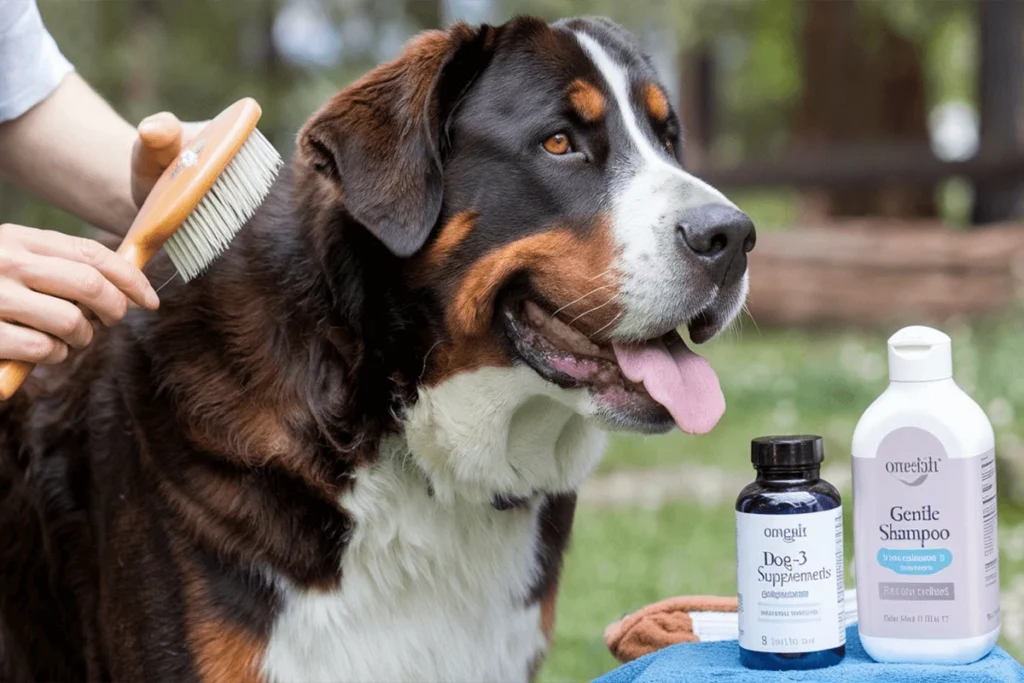
During shedding seasons in spring and fall, a de-shedding shampoo can help loosen dead undercoat fur, making it easier to remove during brushing. After bathing, dry your dog thoroughly with a towel and a blow dryer on a low setting. Brushing after a bath removes loosened fur, reducing shedding in your home.
Regular baths keep your dog clean while controlling Greater Swiss Mountain Dog shedding by removing loose fur before it spreads. A consistent bathing and grooming routine keeps the coat soft, shiny, and irritation-free while making shedding more manageable.
Omega-3 Supplements for Dogs
Diet plays a significant role in maintaining a healthy coat and controlling Greater Swiss Mountain Dog shedding. One of the best ways to support coat health is by adding Omega-3 fatty acid supplements to your dog’s diet. These essential fatty acids help reduce inflammation, improve skin hydration, and promote a shiny, healthy coat that sheds less.
Omega-3s are found naturally in fish oil, flaxseed oil, and krill oil, which can be added to your dog’s food in liquid or capsule form. High-quality dog foods often contain Omega-3s, but supplements can provide additional benefits, especially for dogs experiencing excessive shedding or dry skin. Regular intake of Omega-3s strengthens hair follicles, reducing hair loss and making the fur softer and more manageable.
When introducing Omega-3 supplements, start with small doses and gradually increase based on your vet’s recommendations. Too much can cause digestive upset, so always follow proper dosage guidelines. Along with regular brushing, bathing, and using the right grooming tools, Omega-3 supplements can significantly improve your Greater Swiss Mountain Dog’s coat and make shedding easier to manage.
By incorporating brushing techniques, bathing, and Omega-3 supplements into your dog’s routine, you’ll ensure a healthier coat, reduce shedding, and create a more comfortable living environment for both you and your pet.
Managing Shedding Throughout the Year
Handling Heavy Shedding in Shedding Season
Greater Swiss Mountain Dog shedding becomes significantly heavier during seasonal coat changes in spring and fall. These shedding seasons are when your dog loses its thick winter coat in preparation for summer or sheds its lighter summer coat to grow a dense, insulating layer for winter. Without proper grooming, this increase in shedding can lead to fur accumulation all over your home, making it difficult to manage.
To handle heavy shedding effectively, increase the frequency of brushing. Daily brushing during shedding season helps remove loose undercoat fur before it spreads throughout the house. Using an undercoat rake and a de-shedding brush is essential during this time, as these tools are designed to pull out the dead fur trapped in the undercoat. A slicker brush can help smooth the topcoat and remove any lingering loose hairs.
Bathing during shedding season can also help. A de-shedding shampoo loosens excess fur, making it easier to remove during brushing. Following up with a blow dryer on a low setting helps remove even more loose fur before it has a chance to settle on your furniture. Keeping your home clean with a pet-friendly vacuum and washing your dog’s bedding frequently will further reduce shedding-related messes.
By adjusting your grooming routine during these high-shedding periods, you can keep Greater Swiss Mountain Dog shedding under control and make the transition between seasons much easier for both you and your pet.
Daily vs. Weekly Grooming Needs
Finding the right balance between daily and weekly grooming is key to managing Greater Swiss Mountain Dog shedding. While this breed doesn’t require an intensive grooming schedule like some long-haired dogs, regular maintenance is necessary to keep shedding under control.
Daily grooming is ideal during shedding seasons or if your dog is prone to heavy shedding. A quick daily brushing session with an undercoat rake or de-shedding brush removes loose fur before it spreads throughout your home. This not only reduces shedding but also prevents matting and tangling in the dense undercoat.
Outside of peak shedding seasons, a weekly grooming schedule is often sufficient. Brushing three to four times a week with a combination of a slicker brush, undercoat rake, and de-shedding tool keeps the coat clean and healthy. A weekly bath or wipe-down can also help manage dander and loose fur.
Grooming frequency should also depend on your lifestyle and tolerance for pet hair in your home. If you prefer a cleaner environment with minimal shedding, more frequent brushing will be necessary. However, even with a less rigorous schedule, regular grooming ensures that your Greater Swiss Mountain Dog’s coat stays in optimal condition.
Professional Grooming vs. At-Home Care
When it comes to managing Greater Swiss Mountain Dog shedding, you may wonder whether professional grooming is necessary or if at-home care is enough. Both options have their advantages, depending on your dog’s coat condition and your ability to keep up with regular grooming.
At-home grooming is the most cost-effective and convenient option. With the right grooming tools, including an undercoat rake, de-shedding brush, and slicker brush, you can effectively control shedding on your own. Regular brushing, bathing, and nail trimming can all be done at home, making it a great way to bond with your pet while keeping their coat in top condition.
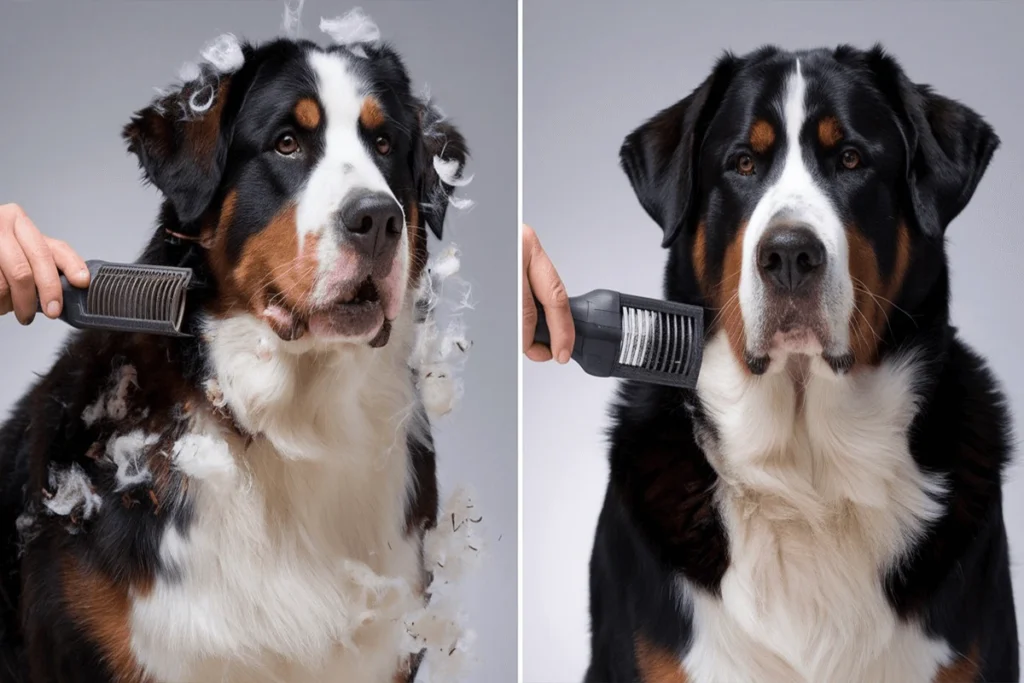
However, professional grooming can be beneficial, especially during shedding seasons. Professional groomers have specialized tools, high-powered blow dryers, and de-shedding treatments that can remove large amounts of loose fur in a single session. They can also trim nails, clean ears, and check for skin issues that might be harder to spot at home. If your dog isn’t a fan of brushing or bathing, professional grooming can make the process easier while ensuring thorough coat care.
Ultimately, a combination of at-home care and occasional professional grooming is ideal for keeping Greater Swiss Mountain Dog shedding under control. If you stay consistent with regular brushing and grooming, professional services may only be needed a few times a year, particularly during peak shedding periods.
Are There Low-Shedding Alternatives?
Comparing to Low-Shedding Dog Breeds
If you want a Greater Swiss Mountain Dog but worry about shedding, you may compare it to low-shedding breeds. Unlike Poodles, Portuguese Water Dogs, and Basenjis, this breed has a thick double coat that sheds year-round, with heavier shedding seasons in spring and fall.
Low-shedding breeds have hair that grows continuously, like human hair, so they need regular haircuts but shed less. The Greater Swiss Mountain Dog, however, naturally sheds as part of coat maintenance. While low-shedding dogs may be better for allergies, they often need frequent professional grooming to prevent matting.
Despite heavier shedding, the Greater Swiss Mountain Dog requires less maintenance than long-haired breeds that need constant trimming. A proper brushing routine, regular baths, and de-shedding tools will reduce loose fur, making shedding more manageable. If you love this breed’s loyal and affectionate nature, a little extra grooming is worth it.
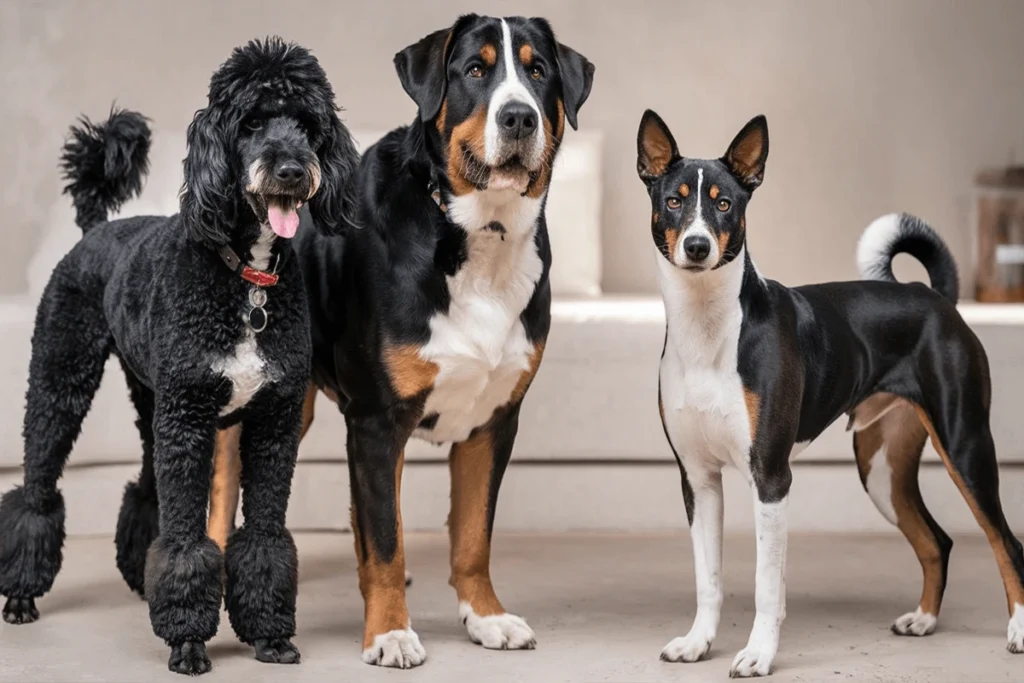
Pros and Cons of a Greater Swiss Mountain Dog’s Coat
The Greater Swiss Mountain Dog’s coat is one of its defining features, but like any breed, it comes with both benefits and challenges. Understanding these pros and cons will help you determine if this breed is a good fit for your lifestyle.
Pros:
- Weather Protection: Their double coat provides insulation, keeping them warm in winter and cool in summer.
- Low Maintenance: Unlike long-haired breeds, their coat does not require frequent trimming or professional grooming.
- Natural Shine: With proper care, their coat remains sleek, glossy, and attractive.
- Dirt Resistance: The short, dense fur does not trap dirt and debris as easily as longer coats.
Cons:
- Heavy Shedding: Greater Swiss Mountain Dog shedding occurs year-round, with two major shedding seasons in spring and fall.
- Not Hypoallergenic: This breed is not suitable for allergy sufferers due to shedding and dander production.
- Regular Brushing Required: To keep the coat healthy and reduce shedding, consistent brushing is necessary.
- Seasonal Fur Management: During peak shedding periods, fur can accumulate quickly in the home if not managed properly.
While the Greater Swiss Mountain Dog’s coat requires attention, a proper grooming routine, pet-friendly vacuum, and occasional professional care can make it manageable.
Final Tips for First-Time Owners
If you’re a first-time owner considering a Greater Swiss Mountain Dog, understanding their shedding needs will help you prepare for proper coat care. Here are some essential tips to make grooming and shedding management easier:
- Invest in the Right Grooming Tools: A de-shedding brush, undercoat rake, and slicker brush will help remove loose fur efficiently.
- Establish a Brushing Routine: Brush at least three to four times per week, and increase frequency during shedding seasons.
- Bathe Strategically: Bathe every 6 to 8 weeks using a moisturizing or de-shedding shampoo to help loosen excess fur.
- Use a Pet-Friendly Vacuum: A HEPA-filter vacuum designed for pet hair will keep your home clean and reduce allergens.
- Consider Omega-3 Supplements: These improve coat health and can help reduce excessive shedding.
- Be Patient and Consistent: Shedding is natural, and regular care will keep it manageable while keeping your dog comfortable.
Owning a Greater Swiss Mountain Dog means embracing their beautiful double coat and the shedding that comes with it. With proper care, you’ll enjoy a loyal, loving companion without being overwhelmed by loose fur in your home.
Conclusion
Managing Greater Swiss Mountain Dog shedding requires consistency, but with the right routine, it becomes easy to handle. This breed’s double coat sheds year-round, with heavier shedding seasons in spring and fall, making regular grooming essential.
Brushing remains the best way to control Greater Swiss Mountain Dog shedding. Using an undercoat rake, de-shedding brush, and slicker brush removes loose fur before it spreads throughout your home. Brushing at least three to four times per week, or daily during shedding season, helps keep the coat healthy and reduces excessive shedding.
Bathing every six to eight weeks with a de-shedding shampoo also minimizes loose hair and keeps their coat clean. Proper drying and brushing after a bath help remove even more dead fur before it falls onto your floors.
A well-balanced diet, including Omega-3 supplements, improves coat health and can reduce excessive shedding. Additionally, using a pet-friendly vacuum helps keep your home clean by efficiently removing loose fur from carpets and furniture.
While Greater Swiss Mountain Dog shedding is a natural part of owning this breed, it doesn’t have to be overwhelming. With regular grooming, proper nutrition, and the right tools, you can keep shedding under control and enjoy all the loyalty and affection this wonderful breed offers.
Lean How To Train your Greater Swiss Mountain Dog Puppy Professionally Here.
Learn The Top Key Differences Between The Two Giant Greater Swiss Mountain Dog vs Bernese Here.
You Can Learn More about the Giant Dogs Breeds From Here
Discover His Other Giant Brother “Bernese Mountain Dog“
Find The Best Stuff For your Pet on PetMD Official.
